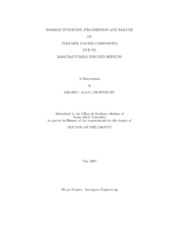| dc.description.abstract | In polymer matrix composites (PMCs) manufacturing processes can induce de-
fects, e.g., voids, fiber misalignment, irregular fiber distribution in the cross-section
and broken fibers. The effects of such defects can be beneficial or deleterious de-
pending on whether they cause failure suppression or enhancement by localized de-
formation processes e.g., crazing, shear yielding and fiber-matrix debonding. In this
study, a computational approach is formulated and implemented to develop solu-
tions for general boundary-value problems for PMC microstructures that accounts
for micromechanics-based constitutive relations including fine scale mechanisms of
material failure. The defects considered are voids, and the microstructure is explic-
itly represented by a distribution of fibers and voids embedded in a polymer matrix.
Fiber is modeled as a linearly elastic material while the polymer matrix is mod-
eled as an elastic-viscoplastic material. Two distinct models for the matrix behavior
are implemented: (i) Drucker–Prager type Bodner model that accounts for rate and
pressure-sensitivity, and (ii) improved macromolecular constitutive model that also
accounts for temperature dependence, small-strain softening and large-strain harden-
ing. Damage is simulated by the Gearing-Anand craze model as a reference model and by a new micromechanical craze model, developed to account for craze initiation,
growth and breakdown. Critical dilatational energy density criterion is utilized to
predict fiber-matrix debonding through cavitation induced matrix cracking.
An extensive parametric study is conducted in which the roles of void shape,
size and distribution relative to fiber in determining damage initiation and evolution
are investigated under imposed temperature and strain rate conditions. Results show
there are significant effects of voids on microstructural damage as well as on the
overall deformational and failure response of composites. | en |


